Rust-Oleum Bathroom Floor Paint: A Complete Guide
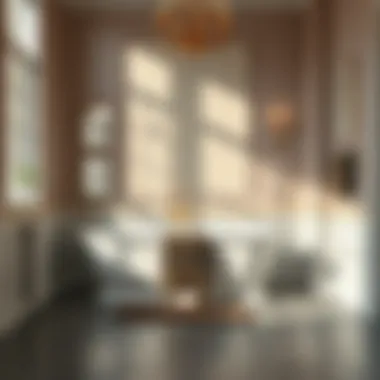
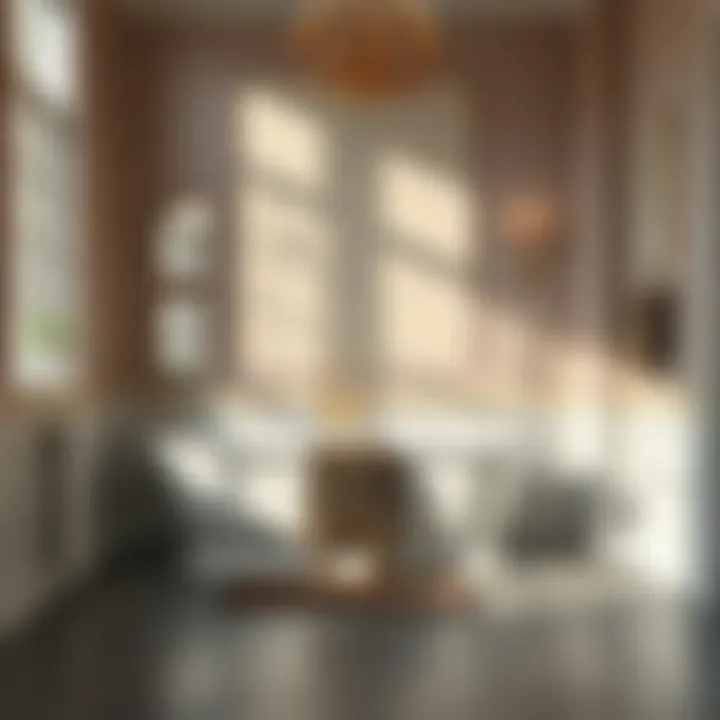
Intro
Transforming a bathroom into a stylish yet functional space can seem like a daunting task. However, with the right tools and products, it becomes a more manageable undertaking. One such tool in the realm of home renovation is Rust-Oleum Bathroom Floor Paint. This unique paint has captured the attention of homeowners who are eager to breathe new life into their bathrooms without breaking the bank.
This guide will delve into the nuances of using Rust-Oleum bathroom floor paint, including preparation techniques, optimal applications, benefits, and ongoing maintenance. Understanding these facets helps to not only create a visually appealing environment but also ensures durability and practicality. As we journey through this guide, readers will better appreciate how to incorporate this versatile paint into their bathroom design.
Additionally, we’ll explore current trends in color palettes and popular styles, providing inspiration and a clear vision for your transformation project.
By engaging with this content, homeowners and design aficionados alike will be equipped with the knowledge needed to elevate their bathroom spaces, improving the overall living atmosphere.
Understanding Rust-Oleum Bathroom Floor Paint
When considering the best options for updating the bathroom floor, Rust-Oleum emerges as a prominent name. This section delves into what makes this particular paint crucial for transforming bathroom spaces effectively. First off, Rust-Oleum bathroom floor paint is designed to withstand the unique challenges of moisture, spills, and foot traffic that typically plague any bath area. Not just a decorative choice, it serves functional purposes that improve safety and aesthetic appeal simultaneously.
Product Overview
Rust-Oleum bathroom floor paint offers a robust solution for homeowners looking to inject some vibrancy into often overlooked spaces. The product line caters to diverse styles and preferences, from modern to classic. Built with durability in mind, it is formulated to endure wet conditions and scrubbing without losing its finish. Understanding these paints is essential for making informed buying choices, ensuring your investment yields enduring results.
Types of Rust-Oleum Products
Rust-Oleum provides a variety of products suitable for bathroom flooring, primarily distinguished by their base composition. Each type presents unique advantages and drawbacks, tailored for specific uses or preferences.
Oil-Based Paints
Oil-based paints are renowned for their longevity and hard, durable finish. They form a tougher layer compared to alternatives, making them an ideal choice for high-traffic areas. One key characteristic of oil-based paints is their excellent adhesion properties, which allows for a stronger bond with surfaces. However, they can take longer to dry, a factor to consider during the application process.
Water-Based Paints
In contrast to oil-based, water-based paints offer a quicker drying time and easier cleanup. They boast lower levels of volatile organic compounds, making them more eco-friendly and safer for indoor air quality. Their flexibility can be an advantage in environments subjected to humidity fluctuations. Yet, some might argue that their durability can be slightly less than that of oil-based varieties. Understanding these nuances is essential for homeowners who prioritize health alongside aesthetics.
Epoxy Coatings
Epoxy coatings are a game changer for those wanting an ultra-durable finish. They offer an extremely strong surface that is resistant to chipping and cracking. The application of epoxy can be more complex due to its two-part composition—resin and hardener—but the results are remarkably long-lasting. Especially suited for areas that see a lot of water, they shine in resilience but also come with a price and a technical application procedure that might not be for everyone.
Key Features
Rust-Oleum bathroom floor paint is not merely about color. Its formulation includes several key features that ensure it meets the specific needs of a wet environment.
Durability
The durability of Rust-Oleum products allows them to withstand harsh conditions better than many traditional flooring solutions. With wear and tear being common in bathrooms, this paint holds up against scratches and accumulated grime. This durability gives homeowners peace of mind, knowing they have made a sound investment for years to come without the need for frequent touch-ups or replacements.
Moisture Resistance
One of the standout characteristics is moisture resistance. Given that bathrooms are prone to splashes and spills, a paint that can resist damage from water is essential. This means that the finish will not bubble or peel when exposed to humidity, providing added longevity to your floor. Homeowners will find joy knowing that their painted floors can handle the rigors of daily life.
Color Retention
Another significant aspect is color retention. Choosing a paint with excellent color retention means that the painted floor will maintain its vibrancy over time. Fading can be a major drawback of many paints, particularly in areas with high sunlight exposure. Rust-Oleum paints are designed to resist fading, ensuring that your design remains fresh and appealing without losing its charm. This feature is not to be taken lightly, especially for those who value interior aesthetics.
"Rust-Oleum provides an opportunity to revitalize your space while adding an extra layer of protection against the elements, making it a wise choice for any homeowner aiming for a durable and attractive bathroom floor."
Why Choose Rust-Oleum for Your Bathroom?
Choosing the right paint for a bathroom floor isn't just about slapping on a color; it’s about considering durability, practicality, and aesthetic appeal. This is where Rust-Oleum shines bright as a solid contender for your bathroom needs. Beyond its reputation, this brand carries a wealth of benefits that cater to both form and function, making your decision a lot easier, and your bathroom a lot prettier.
Advantages Over Traditional Flooring
When compared to traditional flooring options like tiles or vinyl, Rust-Oleum bathroom floor paint holds several aces up its sleeve. First off, installation time is drastically reduced. While tile installation can take days, painting can often be wrapped up in a matter of hours, followed by a shorter drying period. Plus, there's an ease of application that allows homeowners, even those with minimal DIY experience, to take the reins.
Further, the ability to create a seamless look throughout your bathroom is another plus. Traditional flooring might require grout lines that can harbor dirt and mold. With Rust-Oleum, you can achieve a smooth surface that is not only visually appealing but also easier to clean.
Cost-Effectiveness
Let's talk dollars and cents. When budgeting for a bathroom remodel, every little bit counts. Rust-Oleum paints often come at a fraction of the price compared to other materials. Given its long-lasting nature and ability to resist wear and tear, the upfront cost translates into savings in the long run.
Imagine spending less time scrubbing and more time enjoying your new space. For house owners keeping a watchful eye on expenses, using Rust-Oleum can turn out to be both savvy and stylish.
Eco-Friendly Options Available
In today’s world, being eco-conscious is more than just a trend; it’s a responsibility. Rust-Oleum offers eco-friendly formulations that are low in volatile organic compounds (VOCs). These paints minimize harmful emissions that could negatively impact indoor air quality.
This aligns with the growing demand for sustainable living choices. By selecting Rust-Oleum for your bathroom painting project, you’re not only upgrading your space but also contributing to a healthier environment for your family.
"Buying from a brand that prioritizes eco-friendliness is a win-win for both the home and the planet."
Preparation for Painting Bathroom Floors
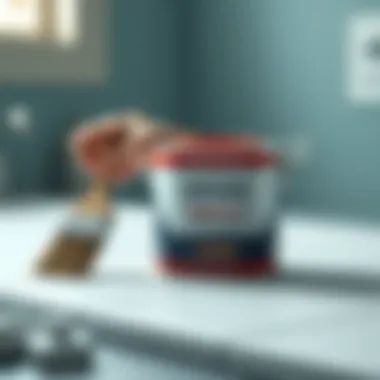
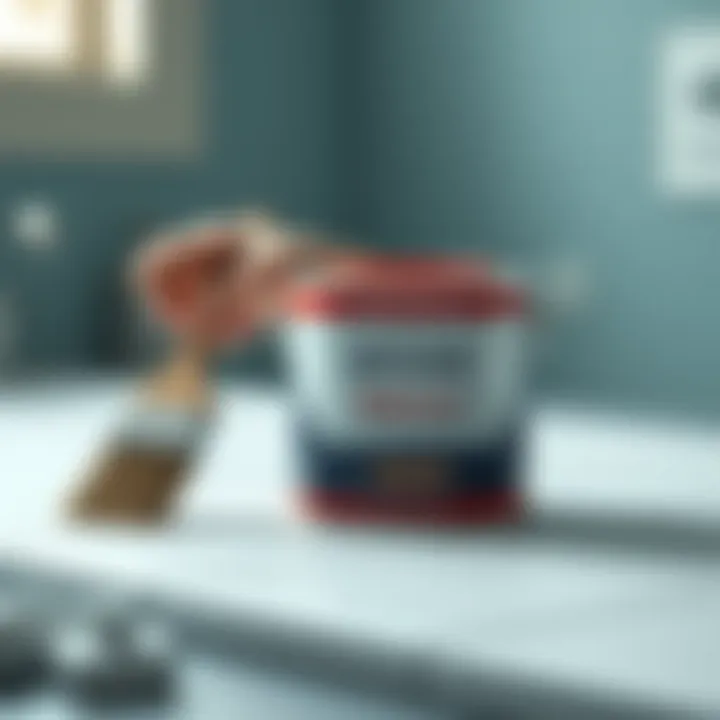
Getting ready to paint your bathroom floor is not just a whim; it’s an essential part of the overall process. This step shouldn't be rushed because the outcome heavily relies on how well you've prepared the surface beforehand. Proper preparation ensures that the paint adheres correctly, resulting in a finish that’s not only beautiful but also long-lasting. Whether you’re a seasoned DIYer or a newbie, understanding this part of the process can save you time, money, and a lot of headaches.
Assessing the Current Floor Condition
Before you even think about picking up that paint brush, the first task is to evaluate the condition of your existing floor. This means checking for damage, wear, and the type of material you’re working with. Uneven spots, cracks, or peeling old paint can spell disaster for your new paint job. An accurate assessment helps to identify what repairs might be necessary before committing to painting.
Start by walking around your bathroom and looking at the floor closely. Are there any visible cracks or holes? Is there any water damage? Take note of any areas that will need attention. In some cases, you might find yourself needing to patch or replace sections of the flooring, which requires both time and materials, but it's better to deal with these issues upfront.
Surface Cleaning Techniques
Cleaning the surface is crucial because any dirt, grease, or existing finishes can prevent the new paint from adhering properly. And trust me, you don’t want to end up with peeling paint a few weeks down the line because you skipped this step.
Removing Existing Finishes
Before you layer on your stunning new coat of Rust-Oleum, you need to strip away any existing finishes. Whether it’s old paint, varnish, or sealants, this step is vital for achieving a professional look and finish. Using a chemical stripper can make this job easier; just be sure to follow the instructions carefully. The key characteristic of removing old finishes is that it creates a clean slate for the new paint. Although it can be labor-intensive, it’s a step that pays dividends once your new floor is looking fine.
Some might find this process tedious, but consider it an opportunity to truly start fresh. Plus, jumping into painting without properly preparing the surface can often lead to poor results.
Deep Cleaning
Once all existing finishes are removed, it’s time for a deep clean. This means scrubbing the surface thoroughly to remove any dust, dirt, or grease that could interfere with paint adhesion. Use a heavy-duty cleaner and scrub hard, especially in areas that accumulate moisture and grime.
A unique feature of deep cleaning is that it doesn’t just prep the surface for paint; it also helps to reveal any more subtle issues, like small cracks that might otherwise be missed. This ensures you catch everything in your initial assessment. If overlooked, these slight imperfections could compromise the integrity of your new painted floor, so a good deep cleaning is well worth the effort.
Repairing and Priming the Surface
After cleaning, it’s crucial to tackle any repairs your floor might need before moving on to priming. Priming helps to create an even surface, and it also serves to improve paint adhesion. It’s a preparatory step that shouldn’t be skipped if you want a flawless finish.
Filling Cracks
Filling cracks is essential for a smooth finish. If you’ve detected any during your initial assessment, use a good quality filler that is suitable for your floor material. The act of filling these imperfections is about more than just aesthetics; it's about preventing moisture from getting under the paint, which could lead to costly repairs later on. A key characteristic of filling cracks is that it helps in avoiding paint chipping or peeling, extending the lifespan of your new bathroom floor.
While it might seem like an extra hassle, investing this time upfront will definitely pay off in the long run with a surface that looks good and lasts longer.
Applying Primer
Finally, once the surface is repaired, applying a primer is the next logical step. Primer helps the final coat of paint to stick better, and it also enhances color retention. This step shouldn’t be viewed as optional, but rather as a critical part of the painting process. The unique feature of using primer is that it can often correct minor blemishes or uneven areas in the surface, as it provides an extra layer of coverage and helps create a uniform base for your paint.
It may take a bit more time and effort, but going through this step not only improves the paint's durability but also enhances its vibrancy, ensuring your new bathroom floor looks as stunning as you intended.
"Preparation is the key to success. Skipping it can lead to shortcuts that don’t pay off in the end."
Application Process
The application process for Rust-Oleum bathroom floor paint is pivotal in achieving a durable and aesthetically pleasing finish. Getting every step right not only enhances the life of the paint but also ensures the bathroom looks polished and professional. Understanding this process allows homeowners and design enthusiasts to effectively rejuvenate their spaces without the fear of peeling or fading.
Tools and Materials Required
Selecting the right tools and materials is crucial for a successful painting job. You will need the following:
- Rust-Oleum Bathroom Floor Paint of your choice.
- Primer suitable for the surface.
- Rollers and brushes for application.
- Paint trays for holding the paint.
- Drop cloths to protect surrounding surfaces.
- Masking tape to create clean lines.
- Sandpaper or floor scraper for surface preparation.
Having these materials on hand can save time and reduce frustration during the application phase.
Step-by-Step Painting Guide
A well-structured step-by-step guide can make the application of paint seem less daunting. Follow these essential steps to achieve your desired finish:
- Prepare the surface by cleaning and priming as discussed in earlier sections.
- Choose your tool for application, whether rolling or brushing.
- Apply the primer and allow it to dry completely.
- Paint with Rust-Oleum, using even strokes to ensure an even coat.
- Let it dry and cure as recommended before using the floor.
Rolling vs. Brushing
When it comes to applying Rust-Oleum bathroom floor paint, you might wonder whether to roll or brush the paint on.
Rolling is typically the more popular choice for larger areas. It covers a lot of ground quickly, which helps when working on a bathroom floor. A key characteristic of using a roller is its ability to create a smooth finish with minimal brush strokes. However, the downside can be the potential for splatter if not handled carefully.
On the other hand, brushing allows for greater control, especially in corners and tight spots. That's a beneficial trait if your bathroom has intricate details or limited space. Yet, this method often requires more time and effort to achieve even coverage, as the brush can leave visible streaks if not applied properly.
Techniques for Even Coverage
Achieving even coverage is imperative to create an appealing look and ensure lasting durability.
One notable technique is to work in sections. By painting one small area at a time, you can better control the application and prevent roller marks or brush strokes from forming. Overlap your strokes lightly—this helps blend the paint seamlessly.
Additionally, consider using a paint extender, especially in hotter conditions where the paint can dry quickly. This product elongates drying time, allowing better manipulation of the paint while maintaining its characteristics.
Drying and Curing Times
Drying and curing times significantly affect the final finish and longevity of your painted bathroom floor. It's essential to respect the drying times recommended by the manufacturer, typically 1-2 hours for touch-dry. However, full curing—a process where the paint reaches its maximum hardness—can take up to a week.
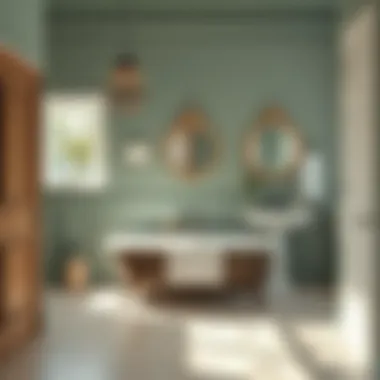
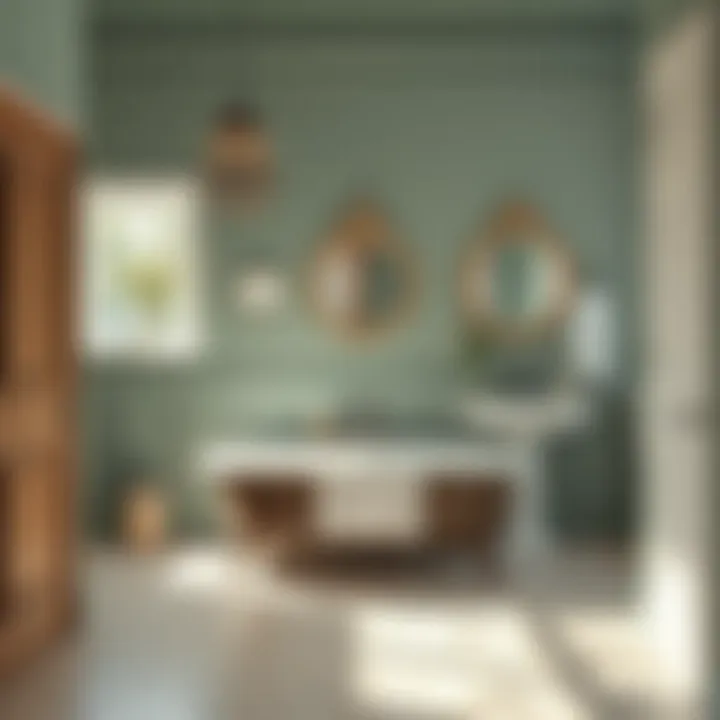
Patience during this phase is key. Avoid walking on the newly painted surface until it has fully cured to ensure beautiful, long-lasting results.
"Taking the time to let your paint cure can save you from headaches down the road. Better a week of no foot traffic than years of flaking paint!"
Post-Painting Care and Maintenance
After your bathroom floor has been beautifully transformed with Rust-Oleum paint, it’s crucial to give it proper care and maintenance. This step is often overlooked but is vital for ensuring the longevity and aesthetic appeal of your newly painted floor. Following adequate post-painting practices can significantly enhance its performance, prevent damage, and keep it looking fresh for years to come.
Initial Waiting Period
Once the paint has been applied, the initial waiting period cannot be stressed enough. This is the time when the paint needs to cure, allowing it to bond effectively with the flooring material. It’s like giving your paint a moment to settle into its new home.
The recommended waiting period varies based on the type of Rust-Oleum product used. Generally, it’s best to keep foot traffic to a minimum for at least 24 to 48 hours after painting. Going too soon could compromise the rules of an effective application. The paint needs to harden adequately, and rushing this can lead to scuffs and chips appearing much earlier than you’d like.
"Letting paint dry isn’t just about time—it's like allowing a fine wine to breathe."
Cleaning Recommendations
Keeping your painted bathroom floor clean doesn’t have to feel like a chore; it’s more about having a smart strategy in place. Regular cleaning helps maintain the floor’s appearance and ensures that dirt and grime don’t build up over time. Here are some best practices:
- Use a Soft Broom or Vacuum: Sweep or vacuum the floor regularly to remove dust and loose particles. Avoid using abrasive cleaning tools that might scratch the surface.
- Gentle Cleaners: When it comes to mopping, opt for pH-neutral cleaners. Harsh chemicals can break down the paint’s finish and dull the color over time. Water mixed with vinegar is a natural alternative to commercial cleaners.
- Spot Cleaning: For stains, try spot cleaning with a soft cloth and mild soap. Ensure you rinse the area well to prevent soap residue from accumulating, as it can attract more dirt in the long run.
Addressing Wear and Tear
Over time, even the most well-maintained floors may encounter wear and tear. However, addressing these issues promptly can avert the need for a complete repaint. Here are some tips on how to handle common issues:
- Minor Scratches and Scuff Marks: For light scratches, a quick buff with a soft cloth can often lift the mark right off. If it’s more stubborn, a little bit of baking soda on a damp cloth can do wonders without damaging the paint.
- Peeling Paint: Should you notice any peeling, gently scrape away the flaking portion and sand down the area to ensure a sleek finish before repainting. Touching up those spots quickly will help maintain a seamless look.
- Preventive Measures: Use area rugs in high-traffic spots to reduce wear and tear. Ensuring that any furniture legs are fitted with protective pads can also prevent scratches.
Adhering to these routines post-painting not only keeps your floors looking great but extends their lifespan, making sure you enjoy your beautifully painted bathroom floors for as long as possible.
Design Considerations
When contemplating the renovation of your bathroom, design considerations become a cornerstone of the process. Choosing Rust-Oleum bathroom floor paint offers a wealth of options to elevate the aesthetic appeal of your space while ensuring durability and functionality. Understanding these considerations can greatly enhance the visual impact and coherence of your bathroom design.
Color Selection
The color of your bathroom floor does more than just please the eye; it can set the entire tone for the area. When selecting a color for your Rust-Oleum floor paint, consider the existing elements in your bathroom, such as tiles, fixtures, and cabinetry. Light colors often create an illusion of a more spacious environment, which is ideal for smaller bathrooms. On the other hand, dark tones can provide a dramatic backdrop that adds depth and intimacy.
- Neutral Options: Colors like beige, gray, and soft white are versatile, allowing for countless aesthetic configurations.
- Bold Hues: If you’re feeling adventurous, consider vibrant colors like turquoise or deep teal, which can invigorate the space, giving it a fresh look.
- Accent Colors: Utilizing contrasting colors can add a modern twist, making your floor a focal point. Think about how the paint color can harmonize with the overall decor.
Patterns and Textures
Once you've settled on a color, exploring patterns and textures adds another layer of sophistication. Rust-Oleum allows for creative freedom with stencils or natural textures that mimic more expensive flooring options, like ceramic or stone. Adding a textured finish can improve slip resistance, which is practical for a bathroom setting.
- Geometric Patterns: These can lend a contemporary flair to your floors, capturing the eye and drawing attention.
- Tile-Like Appearance: Achieving a tile effect with paint can deliver the look of traditional materials without the hefty price tag.
- Textured Finishes: Incorporating textures may provide functional benefits. An anti-slip texture, for example, enhances safety, a crucial aspect in moist environments.
Creating Visual Cohesion with Other Elements
Visual cohesion in a bathroom lies in the unification of various design components. The floor paint should align with the existing decor and theme of the bathroom. Consider how the floor color complements the walls, fixtures, and accessories. A coherent design makes a bathroom feel more organized and enhances the flow of the space.
- Accessorizing: Choose rugs, towels, and bathroom accessories that echo the colors found in your floor paint.
- Wall Colors: Wall paint should harmonize or contrast attractively to your floor. For instance, a soft pastel wall with a vibrant floor can create a balanced yet dynamic atmosphere.
- Lighting: Consider how natural and artificial lighting will interact with your painted floors. The same color can look quite different under various lighting; testing a sample under different lights can save future headaches.
In essence, thoughtful design considerations not only amplify the visual allure of your bathroom but also ensure a harmonious and inviting atmosphere. The choices you make regarding color, patterns, textures, and cohesion will resonate through the entire space, creating a sanctuary that feels both personal and practical.
Incorporating these elements effectively makes all the difference. By blending aesthetics with functionality, you can turn your bathroom into a beautiful and durable space that reflects your style and meets your everyday needs.
Comparative Analysis with Other Flooring Options
In the realm of home improvement, especially when it comes to bathroom renovations, selecting the right flooring is crucial. This section dives into a comparative analysis of Rust-Oleum bathroom floor paint against other popular options available, including tile and vinyl. Knowing the strengths and weaknesses of each type can help homeowners make informed decisions that marry aesthetics with functionality.
Tile vs. Paint
Tile flooring is often hailed for its durability and classic appearance, making it a widely chosen option for bathrooms. However, it's worth considering how it stacks up against painted floors.
- Durability: Tiles can take a beating, but grouting may hazard mold and mildew. On the flip side, Rust-Oleum paint provides moisture resistance when properly applied, making it a viable option.
- Installation: Tiles require meticulous installation and often just a pro can skillfully lay them. Painting a floor is generally more manageable and typically doesn't necessitate professional help, saving time and expenses.
- Visual Appeal: While tile comes in diverse styles, painted floors offer endless customization. With Rust-Oleum’s wide range of colors, homeowners can curate whatever look suits their style—be it a chic modern vibe or a rustic farmhouse feel.
All in all, while tile stands strong against wear, a fresh paint job can provide just as much personality and practicality, and at a fraction of the hassle.
Vinyl vs. Painted Concrete
Vinyl flooring is another frontrunner in bathroom settings, favored for its ease of maintenance and affordability. However, painted concrete expands the narrative by introducing unique elements to the flooring conversation:
- Cost: Vinyl can be cheaper upfront, yet painted concrete can last longer when treated right. Depending on the quality and method of application, Rust-Oleum paint may prove to be a worthwhile long-term investment.
- Style Options: Vinyl may limit design choices; being a manufactured product, it generally comes in predetermined patterns. Conversely, painted concrete allows homeowners to adopt a DIY approach. They can achieve various textures and patterns that suit their personal aesthetic.
- Longevity: Both options require care, but with meticulous attention, a painted concrete floor can outlast vinyl. Moreover, Rust-Oleum offers excellent bonding, meaning paint, when maintained well, holds up quite nicely in moisture-prone areas like bathrooms.
Cost and Installation Time Comparison
When weighing flooring options, cost and installation duration undeniably play pivotal roles. The cost breakdown between Rust-Oleum paint and traditional flooring systems often shows that paint is easier on the wallet:
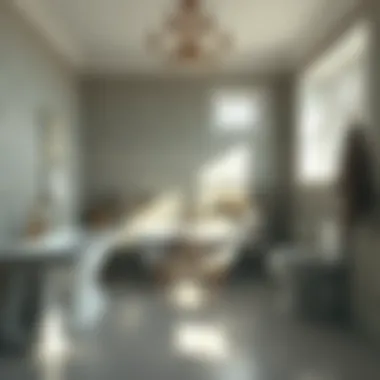
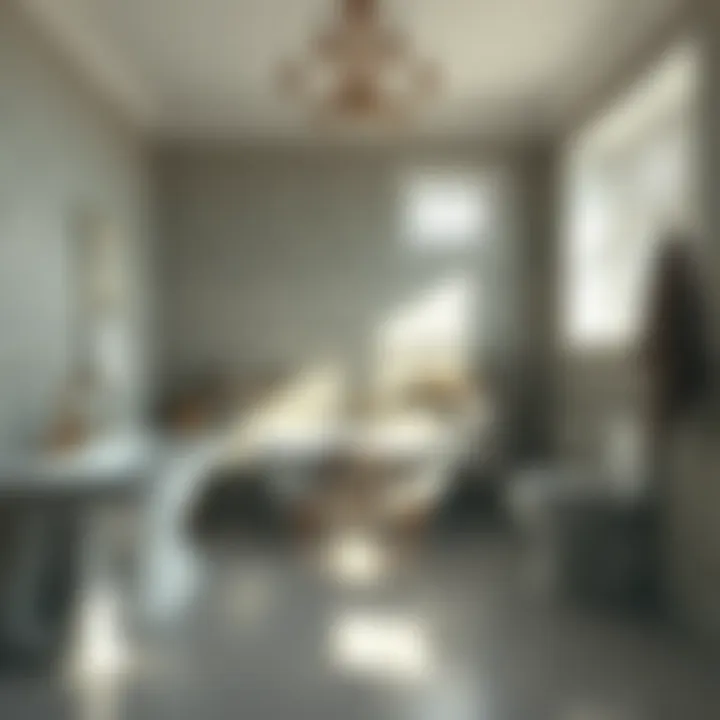
- Initial Expenses: While the paint itself typically costs less than tile or vinyl, don’t forget to factor in the preparation and primer. An investment in quality tools and supplies may initially seem steep, but the overall expenditure generally remains lower than installing tiles or vinyl sheets.
- Installation Duration: Painting a bathroom floor is relatively swift. Depending on the size of the space, a simple paint job usually takes a matter of a few hours, plus drying times.
- DIY vs. Professional Help: With tile and vinyl, particularly installation for intricate designs or large bathrooms, hiring professionals can significantly increase costs and time frames associated with the project.
"When in doubt, a savvy homeowner should consider Rust-Oleum paint due to its ease of use and adaptability, aligning with the budget and style needs."
Common Mistakes to Avoid
When it comes to transforming your bathroom floors with Rust-Oleum paints, certain pitfalls can throw a wrench in your plans. Understanding and avoiding these common mistakes is crucial—not only to ensure a beautiful finish but also for the durability and longevity of your flooring. These blunders can cost time and money, making awareness a key aspect of your painting project.
Neglecting Surface Preparation
One major mistake that many homeowners make is skimping on surface preparation. Think of it like trying to build a house on sand; without a solid foundation, everything crumbles.
Before applying Rust-Oleum paint, it’s imperative to clean and assess the current floor condition thoroughly. This often means scrubbing away dirt, grease, and any previous coatings that might interfere with adhesion. If the existing finish is flaky, it can create all sorts of issues later on.
A proper cleaning routine might include:
- Removing existing finishes using a suitable solvent
- Deep cleaning with a heavy-duty cleaner
Spending the extra time on preparation will pay dividends, so don’t brush this step under the rug. It’s about laying the groundwork for a paint application that sticks and stays vibrant for years to come.
Improper Application Techniques
Next up on the list is improper application techniques. It’s tempting to just dive in with a roller or brush and hope for the best. However, inconsistent application can lead to streaks, splatters, and an overall splotchy finish that does nothing for your bathroom aesthetic.
Using the right tools and techniques turns the paint job from drab to fab. Consider the following:
- Rollers vs. Brushes: Each has its purpose. Rollers cover large areas quickly, while brushes are perfect for edges and tight spots.
- Applying even pressure: Keep your hand steady; avoid pressing too hard, as it can lead to puddling.
Following a calculated process ensures that you’re not only enhancing the look of your floors but also promoting an even drying time across the surface, which ultimately leads to better durability.
Ignoring Manufacturer Recommendations
Finally, don’t ignore manufacturer recommendations. Rust-Oleum provides specific instructions for their products for a reason. Ignoring these guidelines can hinder the performance of the paint. For instance, if the instructions suggest applying a particular primer, failing to do so can result in chipping or peeling.
Here are some recommendations to heed:
- Review the drying and curing times.
- Stick to suggested mixing ratios if any.
- Be mindful of temperature and humidity levels during application, as these factors influence drying time and paint adhesion.
Manufacturers, like Rust-Oleum, know their products inside and out. Their recommendations might feel like a hassle, yet following them can make or break your project.
Remember, forewarned is forearmed. Avoiding these common mistakes not only streamlines your process but also cuts down on potential future aggravations.
By steering clear of these pitfalls, you’ll set the stage for a successfully painted bathroom floor that’s both stylish and durable.
Frequently Asked Questions
In any deep dive into a product like Rust-Oleum bathroom floor paint, it’s crucial to address common questions that surface from the minds of both homeowners and designers. This section serves as a beacon of clarity, guiding readers through uncertainties about safety, longevity, and application versatility. Understanding these elements not only helps in making informed decisions, but it also assuages any worries about using this paint in critical spaces like bathrooms. With every fresh coat of paint, comes a fresh set of inquiries. Let’s explore these prevalent queries.
Is Rust-Oleum Paint Safe for Bathrooms?
Safety remains a top priority when it comes to home improvement products. Rust-Oleum paints are specifically formulated with safety in mind, especially for spaces prone to moisture and humidity like bathrooms. Often, the concern revolves around the release of volatile organic compounds (VOCs) that can affect indoor air quality. Fortunately, Rust-Oleum has several low-VOC and even zero-VOC options that mitigate these risks. This means you can enjoy your newly painted floors without worrying about harsh fumes lingering around, provided you follow the instructions correctly.
"Using low-VOC paints is like opting for a gentle breeze over a thunderstorm – safer and pleasant."
Additionally, if there's a worry about slips due to wet surfaces, many Rust-Oleum formulations include anti-slip properties, providing a bit more assurance during those quick bathroom visits.
How Long Does the Paint Last?
Durability is an essential factor when selecting a floor paint, especially in high-traffic areas like bathrooms. Rust-Oleum bathroom floor paints generally boast impressive longevity, typically ranging from five to ten years if maintained properly. The lifespan of the paint can be affected by several variables, such as the condition of the surface before application and environmental factors like humidity levels.
To assure this longevity, applying the paint under optimal conditions—such as a well-ventilated space and maintaining appropriate temperatures during application—will significantly enhance performance. Always remember, a little patience during the drying and curing times pays off in the long run as it ensures that the paint bonds well and withstands daily wear and tear.
Can Use it on Other Surfaces?
One of the strengths of Rust-Oleum bathroom floor paint lies in its versatility. While it’s explicitly designed for floors, many of its products can also be applied to various surfaces, including concrete, wood, and vinyl. This flexibility allows homeowners to explore creative possibilities in their renovations.
However, it’s wise to consider the texture and resilience of the surface you wish to paint. For instance, while painting over tiles can give a charming makeover, it’s essential to ensure the paint used is suitable for that purpose. Rust-Oleum products often come with specific guidelines, clearly stating acceptable surfaces and the preparation required for effective adhesion.
In joyful exploration of paint options, homeowners can transform not just bathroom floors but potentially other spaces as well, creating a consistent style throughout the home.
End
In wrapping up our discussion on the various facets of Rust-Oleum bathroom floor paint, it's clear that this product is more than just a coating; it represents a commitment to enhancing the functionality and aesthetics of your bathroom space. Utilizing Rust-Oleum not only transforms floors but also caters to the unique challenges of a wet environment. This makes it a particularly valuable option for bathrooms, where moisture can wreak havoc on traditional flooring materials.
The importance of this topic hinges on the need for practical solutions that address both style and durability. As homeowners seek to strike a balance between appealing designs and resilience, Rust-Oleum paints stand out. Choosing the right paint isn’t merely about aesthetics; it's about investing in longevity and maintenance ease. Therefore, the insights shared in this guide serve to illuminate the journey—from preparation and application to post-painting care—that is essential for successfully implementing this transformative product.
Recap of Key Points
- Product Variety: Rust-Oleum offers several options, including oil-based, water-based paints, and epoxy coatings, each catering to specific needs and preferences.
- Surface Preparation: Understanding the thorough cleaning, repair, and priming process is crucial to ensure optimal adhesion and finish.
- Application Techniques: Effective tips on rolling and brushing techniques can help achieve even coverage, which is vital for durability.
- Maintenance Considerations: Regular care and cleaning are necessary to keep painted floors looking great and resisting wear over time.
Final Thoughts on Rust-Oleum Bathroom Floor Paint
When it comes to revitalizing your bathroom space, Rust-Oleum is a reliable choice. Its paints not only provide protection against moisture and wear but also allow for creative expression through color and texture. As you ponder your flooring options, consider how this product not only meets practical demands but also aligns with your personal style.
In essence, investing in Rust-Oleum bathroom floor paint is more than just a cosmetic upgrade—it's a strategic move towards achieving a beautifully functional home environment. For anyone looking to embark on this project, the guidelines outlined herein serve as a roadmap to navigate every integral step. By prioritizing preparation, application, and post-application care, you’re not only enhancing your space but also ensuring it stands the test of time.



